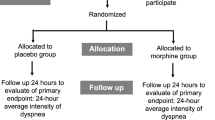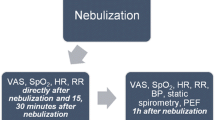Abstract
Background
Respiratory depression is the opioid adverse effect feared most by physicians. This may hinder adequate dosing in cancer pain. The study was conducted to examine the respiratory function of patients with advanced cancer receiving significant doses (>100 mg/24 h) of oral morphine.
Patients and methods
Consecutive pain-free hospice inpatients with advanced cancer receiving high-dose immediate-release oral morphine were evaluated. A single assessment of respiratory rate (RR), arterial blood gas (ABG), and peak flow rate (PFR) was made at assumed morphine steady state. Venous blood was drawn for a trough morphine plasma level.
Results
Of 31 patients who consented to examination, 20 completed the study assessment; 12 had chronic bronchitis. The median morphine dose was 30 mg 4-hourly (range 20 to 90 mg). Only one patient had evidence of ventilatory impairment.
Conclusions
Morphine does not commonly cause chronic ventilatory impairment when given in this way in this population even in the presence of pre-existing or concurrent respiratory disease. Oral morphine given repeatedly in individualized dosage is a safe and efficacious analgesic in the majority of those with advanced cancer.
Similar content being viewed by others
References
Berry J (1994) Misconceptions about morphine use in cancer patients. Am Pharm NS34(4):34–36
Foley KM (1995) Misconceptions and controversies regarding the use of opioids in cancer pain. Anticancer Drugs 6 [Suppl 3]:4–13
Redmond K (1997) Organizational barriers in opioid use. Support Care Cancer 5:451–456
Rigg JR (1978) Ventilatory effects and plasma concentration of morphine in man. Br J Anaesth 50:759–765
Eckenhoff JE, Oech SR (1960) The effect of narcotics and antagonists upon respiration and circulation in man. Clin Pharmacol Ther 1:483–524
Spector S (1971) Quantitative determination of morphine in serum by radioimmunoassay. J Pharmacol Exp Ther 178:253–258
Merskey H (1983) Diamorphine (heroin) and cancer pain. Can Med Assoc J 129:931–932
Twycross RG (1982) Morphine and diamorphine in the terminally ill patient. Acta Anaesthesiol Scand Suppl 74:128–134
Walsh TD, Saunders CM (1984) Heroin and morphine in advanced cancer. N Engl J Med 310:599
Walsh TD, Saunders CM (1981) Oral morphine for relief of chronic pain from cancer. N Engl J Med 305:1417–1418
Walsh TD (1984) Oral morphine in chronic cancer pain. Pain 18:1–11
Walsh TD (1984) Opiates and respiratory function in advanced cancer. Recent Results Cancer Res 89:115–117
Budd RD, Leung WJ, Yang FC (1980) RIA opiates: structure versus reactivity. Clin Toxicol 17:383–393
Grabinski PY, Kaiko RF, Walsh TD, Foley KM, Houde RW (1983) Morphine radioimmunoassay specificity before and after extraction of plasma and cerebrospinal fluid. J Pharm Sci 72:27–30
Keats AS (1985) The effect of drugs on respiration in man. Annu Rev Pharmacol Toxicol 25:41–65
Leino K, Mildh L, Lertola K, Seppala T, Kirvela O (1999) Time course of changes in breathing pattern in morphine- and oxycodone-induced respiratory depression. Anaesthesia 54:835–840
Thompson PI, Joel SP, John L, Wedzicha JA, Maclean M, Slevin ML (1995) Respiratory depression following morphine and morphine-6-glucuronide in normal subjects. Br J Clin Pharmacol 40:145–152
Bulow HH, Linnemann M, Berg H, Lang-Jensen T, LaCour S, Jonsson T (1995) Respiratory changes during treatment of postoperative pain with high dose transdermal fentanyl. Acta Anaesthesiol Scand 39:835–839
Borgbjerg FM, Nielsen K, Franks J (1996) Experimental pain stimulates respiration and attenuates morphine-induced respiratory depression: a controlled study in human volunteers. Pain 64:123–128
Bruera E, Macmillan K, Pither J, MacDonald RN (1990) Effects of morphine on the dyspnea of terminal cancer patients. J Pain Symptom Manage 5:341–344
Dudgeon DJ, Kristjanson L, Sloan JA, Lertzman M, Clement K (2001) Dyspnea in cancer patients: prevalence and associated factors. J Pain Symptom Manage 21:95–102
Dudgeon DJ, Lertzman M (1998) Dyspnea in the advanced cancer patient. J Pain Symptom Manage 16:212–219
Dudgeon DJ, Lertzman M, Askew GR (2001) Physiological changes and clinical correlations of dyspnea in cancer outpatients. J Pain Symptom Manage 21:373–379
Campbell C, Weinger MB, Quinn M (1995) Alterations in diaphragm EMG activity during opiate-induced respiratory depression. Respir Physiol 100:107–117
Wanke T, Lahrmann H, Formanek D, Zwick B, Merkle M, Zwick H (1993) The effect of opioids on inspiratory muscle fatigue during inspiratory resistive loading. Clin Physiol 13:349–360
Quevedo F, Walsh D (1999) Morphine-induced ventilatory failure after spinal cord compression. J Pain Symptom Manage 18:140–142
Donnelly S, Davis MP, Walsh D, Naughton M (2002) Morphine in cancer pain management: a practical guide. Support Care Cancer 10:13–35
Acknowledgements
The authors appreciate the assistance of Dr. P. Grabinski in the assay of plasma morphine, Dr. R. Baxter in performing the arterial blood gas analyses, Dr. M. Srivastava in reviewing the blood gas results, and Dr. C. Saunders for her advice and support.
Author information
Authors and Affiliations
Corresponding author
Additional information
The Harry R. Horvitz Center for Palliative Medicine is a World Health Organization demonstration project in palliative medicine.
Rights and permissions
About this article
Cite this article
Walsh, T.D., Rivera, N.I. & Kaiko, R. Oral morphine and respiratory function amongst hospice inpatients with advanced cancer. Support Care Cancer 11, 780–784 (2003). https://doi.org/10.1007/s00520-003-0530-0
Received:
Accepted:
Published:
Issue Date:
DOI: https://doi.org/10.1007/s00520-003-0530-0




